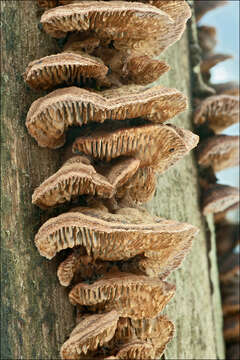Gloeophyllum-abietinum_3

Description:
Gloeophyllum abietinum (Bull.: Fr.) Karst.DE Tannen-BlttlingSlo.: hojeva tramovkaDat.: Jan. 03. 2014Lat.: 46.34408 Long.: 13.67321Code: Bot_779/2014_DSC9621Habitat: Steep, rocky mountain slope, open rocks and light mixed wood, Ostrya carprinifolia, Picea abies, Fagus sylvatica, Fraxinus ornus, Corylus avellana dominant trees, calcareous ground, warm, dry, wind exposed place, exposed to direct rain, average precipitations ~ 3.000 mm/year, average temperature 7-9 deg C, elevation 655 m (2.150 feet), alpine phytogeographical region.Substratum: dead, debarked, partly still standing, partly loosely lying on ground, trunk of Picea abies in its initial stage of disintegration.Place: Lower Trenta valley, next to the trail from village Soa to Lemovlje flats, East Julian Alps, Posoje, Slovenia EC Comments: Four species of the genus Gloeophyllum have been reported in Slovenia: G. odoratum, G. separium, G. abietinum and G. trabeum. Far the most common is G. odoratum. It is one of the most frequent Polypores in my region. Number of my observations goes in several ten. G. separium follows, while both others are much, much rarer. This observation is my first find of G. abietinum, while I haven't yet found G. trabeum. Literature states G. abietinum to be rare or very rare in Britain and Europe in general, while Ref.:(3) states it is common in CH. Rivarden and Bernicchia say it is a perennial species, while Breitenbach and Krieglsteiner consider it as an annual species. Also there are two writings of genus name in use - Gloeophyllum and Gloephyllum. Index Fungorum uses the first one.Growing in groups of many pilei; their dimensions up to 4 x 2 cm, quite thick at the base, pore layer thicker than context; smell distinctive, on leather or tobacco; taste mild, slightly bitter after a while; context tough, fibrous; SP faint whitish-ochre, oac858 (?).Spores smooth. Dimensions: 10 [11,5 ; 12] 13,5 x 3,2 [3,7 ; 3,9] 4,5 microns, Q = 2,6 [3 ; 3,1] 3,5 ; N = 43 ; C = 95%, Me = 11,7 x 3,8 microns; Qe = 3,1. Olympus CH20, NEA 100x/1.25, magnification 1.000 x, oil, in water, Congo red.AmScope MA500 digital camera.Herbarium: Mycotheca and lichen herbarium (LJU-Li) of Slovenian Forestry Institute, Vena pot 2, Ljubljana, Index Herbariorum LJFRef.:(1) S. Buczacki, Collins Fungi Guide, Collins (2012), p 496.(2) L. Ryvarden, R.L. Gilbertson, European Polypores, Fungiflora, Vol.1. (1993), p 285.9-12/3-4(3) A. Bernicchia, Polyporaceaes.l., Fungi Europaei, Vol. 10., Edizioni Candusso (2005), p 243.9-11(12)/2.8-3.5(4)(4) J. Breitenbach, F. Kraenzlin, Eds., Fungi of Switzerland, Vol.2. Verlag Mykologia (1984), p308.10-13/3-4(5) G.J. Krieglsteiner (Hrsg.), Die Grosspilze Baden-Wrttembergs, Band 1., Ulmer (2000), p 524.
Included On The Following Pages:
- Life (creatures)
- Cellular (cellular organisms)
- Eukaryota (eukaryotes)
- Opisthokonta (opisthokonts)
- Nucletmycea
- Fungi (mushrooms, lichens, molds, yeasts and relatives)
- Dikarya
- Basidiomycota (basidiomycete fungi)
- Agaricomycetes (Mushroom-Forming Fungi)
- Gloeophyllales
- Gloeophyllaceae
- Gloeophyllum
- Gloeophyllum abietinum
This image is not featured in any collections.
Source Information
- license
- cc-by-nc-sa
- copyright
- Amadej Trnkoczy
- photographer
- Amadej Trnkoczy
- original
- original media file
- visit source
- partner site
- Flickr Group
- ID


